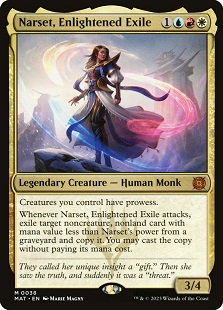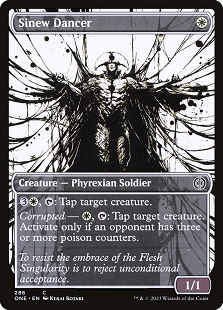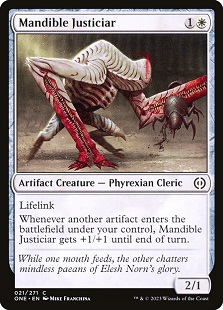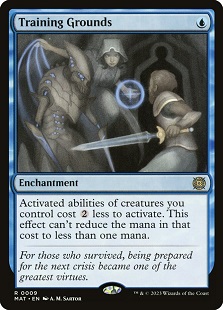At Magic Con Minneapolis, I picked up a media badge in order to secure some interviews.
I've been wanting to meet Meris Mullaley for years and catching up with Ovidio is always a delight. You can read up on a previous chat I had with him in Bird is the Word with Art Director Ovidio Cartagena.
 | 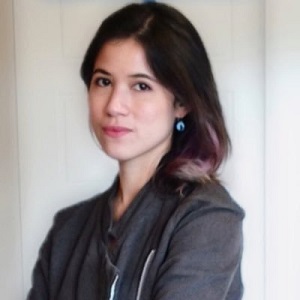 |
Ovidio Cartagena:
https://twitter.com/ovidiocartagena
Meris Mullaley:
https://twitter.com/FabricAlchemist
From a recording I did at the time, this is the transcript.
Meris Mullaley
Mike: Hello Meris! Let's get started. You're a world building manager - what does that mean?
Meris: Within world building overall within Magic, there's two large disciplines. One is the writers and narrative designers and then there's the art side. I manage the words people. Our team name is referred to as "World Building Design" because we work very closely with the mechanical game designers.
I see my team very much as either at the crossroads or translators of the game mechanics into the flavor of the setting that we are world building. When our team members are acting as set leads, they'll work closely with the art lead to build the world, figure out the visuals, what creatures are here, what people are here, what does it look like and then we also write the art descriptions. So, we're looking at the card records and mechanics, and we're like great, this 1/1 Blue flyer probably is x.
Mike: So you manage both the freelancers and the internal folks?
Meris: I predominantly manage the internal folks and then for the freelancers, the lead who runs creative text and I make sure they have the right materials. They have the right NDAs, and contracts.
Mike: Style guide process - the art obviously has a push, which we know. How would you say you put the finishing touches on a style guide? Do you put the final blessing in? Or is there a group - once everything is in, all the assets are done...
Meris: Really, the set leads, the narrative lead and the art lead, are the ones who lead the world guide. And they're forming it from all the stuff they've built from the concept push, and also all the notes from the worldbuilding they've been doing. They write that out, overwrite it, do all the editing, and then make it the final document that can be shared with all the external artists and writers.
Mike: You make sure they have all the assets, and all the pieces in there before then?
Meris: Yes!
Mike: I have asked a few known associates for some questions, we have way too many, and we'll never get to them all, which is neat, but with the increasing number of legendaries per set...
Meris: *laughs*
Mike: ...obviously commander is popular, weird, many of them story adjacent. How has that impacted world building?
Meris: There are a couple different approaches to legends. There are legends and planeswalkers who you might see over a couple sets. There are others you may see that are made when writing art descriptions. We call those "card level solves," versus larger strategy story level solves.
My team is going to be like, "Meris why are you going to say it doesn't have an impact on us, like of course it has an impact on us." I think perhaps the better way to looking at it is the increase in legends is one aspect of just the way Magic sets have grown in scope. It used to be, when I started as a producer, a set was 265 cards. Regular and foil. That was it. With our showcase cards, with now folding Commander into a lot of our products, what it has done is increase the size of our art waves, and increase the number of cards we need to write art descriptions for.
Imagine the world guides of like six years ago vs. recent. A lot of extra world building in a world guide was overflow, when you went to write the actual card content. But now, we're now using a lot more of it. There's more to do. Something we're iterating on is how much does the process need to evolve? How much is just getting more people working on it? Sometimes the answer is both.
Mike: That's the easy answer of course.
I have a question on planeswalkers. In the last set, a few of them died. A few. But that changes things. They have been the visual key, the visual brand for almost 15 years. Now there are fewer planeswalkers competing in that space. Obviously, you're years ahead of us now. Are there any intended or unintended consequences or just interesting nuances. You can't talk about too much in the future, but there are things that might settle from that?
Meris: I think there's a potential for the planeswalkers who retain their spark, to feel more powerful and unique in a certain way. I think there are other opportunities that I'm personally very excited about. Narset is one of my favorite characters, but I haven't been able to put her on the front of a commander deck in a very long time, because she's been a planeswalker, but now I can.
Mike: Good answer. Clearly you could play the first Narset but...yeah, Narset, Enlightened Master is a bit oppressive.
So, who is your favorite commander?
Meris: I wanted it to be Narset, now it can actually be.
Mike: Now it can.
A more personal question from Philly and Tokyo in 2018. In Tokyo in 2018, they had bits of the style guides from the Guilds of Ravnica. They had them under plexiglass. Parts were blocked out, makes sense, some things unreleased, but they were blocked out thematically, so some things were burned out, or melted, or moss overgrown. it was very fun.
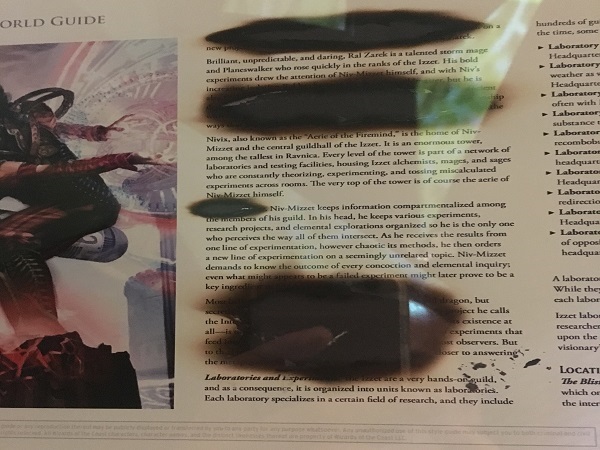
Screenshot from my recap article
Meris: Clever. Represented by each guild!
Mike: Right! It was represented by each guild, right! It was very, very neat.
It was the first example ever of having that beyond an article on those pieces, where folks got to see their guild and get to see unreleased info. Even though a lot of it is kind of inferred yet kind of new.
There is that opportunity, the lane in our art shows to do that. But there is no process, there is no way to do that. And I'm curious if there is a way, now that we have Magic Cons, four a year, if there would be a way we could start having that conversation?
Meris: Probably. We have a creative director, that I think is probably the person to involve in those conversations. Then I think, it's a conversation with the events team. We included some select pages from the Neon Dynasty style guide in our building worlds program.
Meris: We also included concept art in Ikoria. So, we're not opposed to sharing that content, but I think it's very strategic. It's figuring out what things are helpful to share. Or we're not ready to share yet.
Mike: Examples like Gruul on Ravnica. We actually don't know much about them. Not really. But in style guides, there's actually a lot.
Meris: From my perspective, as well, I think Jontelle mentioned this, both transparency, how much we can talk about things more.
I'm somebody who loooooves behind the scenes featurettes on DVDs. I will absorb all of those and learn how they made my favorite movies and favorite tv shows. I want to be able to share, I personally want to be able to share some of that content and that process with the fans of Magic so they can understand the work and the craft that goes into it, and the humans behind it. I think it's just a matter of figuring out our strategy from our team about how we want to communicate about our work, and how do we want to talk about it and share it.
Mike: Right How does it get presented? The thought that Don Maddock had was an exhibition guide.
Meris: Mmm hmmm!
Mike: That would be an easy way to have commentary and analysis, and all these things.
Meris: Right, rather than just straight out.
Mike: Right, instead of just a copy paste, which is a bit dull and not as great as folks who can add nuance looking back over a year or two later.
I want to be mindful of time, unless you have any for me?
Meris: Who has been the character or plane you've been most excited about?
Mike: Innistrad because I grew up spending oodles of time in Germany.
Meris: Oh sweet.
Mike: Even though it's Prussia, I know, it's fine. It's Germany, It is, it's Germany. Always Innistrad.
Ovidio Cartagena
Mike: Hello Ovidio, let's start from the top. Who is your commander?
Ovidio: I just did an article on that, it's Jenara, Asura of War, painted by Chris Rahn.
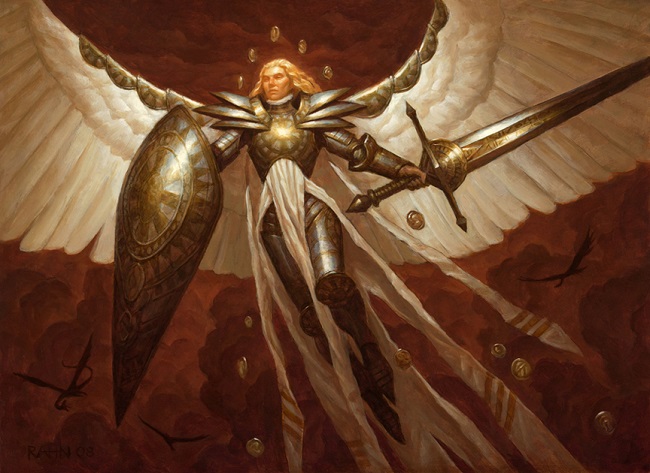
Jenara, Asura of War by Chris Rahn
Mike: It's a goodie.
Ovidio: Yes, I love Bant. But...I got around it, in a weird way. Teferi, Hero of Dominaria and Tamiyo, Field Researcher are two of my favorite planeswalkers. So, I was like, I will find an excuse to use these. I started building there, I didn't start with Jenara. Then I found the Bant commander, now I started turning it into Superfriends counters. It's kind of scary so I never win because I become the target.
Mike: It's the deadpan face, you don't know where he's at!
Ovidio: They don't know what I'm bringing to the table. That's what I got to say. I love Bant. Another reason why, is I love the characters but I love the color combination. If it was Red and Green, ahhh, it's like Tamiyo...but it's red and green. *sigh* I don't like it. The artist in me, the picky artist.
Mike: I found a really great quote from Jeremy Jarvis that said "we need to find ways to ensure that we can keep Magic's very high visual standards as we continue to create more and more things each year." You make more art than the Vatican than even their high period. I counted. Which is wild. And I'm just curious, how do you play a role in protecting that brand standard of quality?
Ovidio: Quality is a two-prong question. You can talk about quality in creativity and quality in technique. We've opened up Magic for people of many backgrounds to participate as artists in the set, so there are many styles, you become an artistic polyglot, in understanding which artist is the best at what. That's probably the toughest thing to learn as an art director. The hardest things for me to learn, what is an artist best at. What can I give them? What are they good at and they can be great at? That I am able to give them.
Mike: The stretch projects.
Ovidio: You have to give people the opportunity to fail. Because they learn from that. The other thing I learned was how to let their style breathe. Because I came from classical art, and you know that. So, I was like oh you know what that wrist is not exactly right he he he. So, I started being nitpicky at the beginning, very nitpicky and you saw the beginnings of that. (gestures to Meris.)
Meris: Mmm hmmm.
Ovidio: I think I've learned a lot when to pull, when to push, and when to just let things take their course. So, I'm working with Allen Williams on a piece and I have to remind him, "Allen, I want your awesomeness here, so..." Obviously I can't tell you which piece Mike, but "...lean into what you know how to do." Right? Because that's another thing, many artists are like "ohmigod, I'm doing for Magic and it has to look like someone else's art.
Mike: It's the bullseye middle - Tyler Jacobson. It has to be...
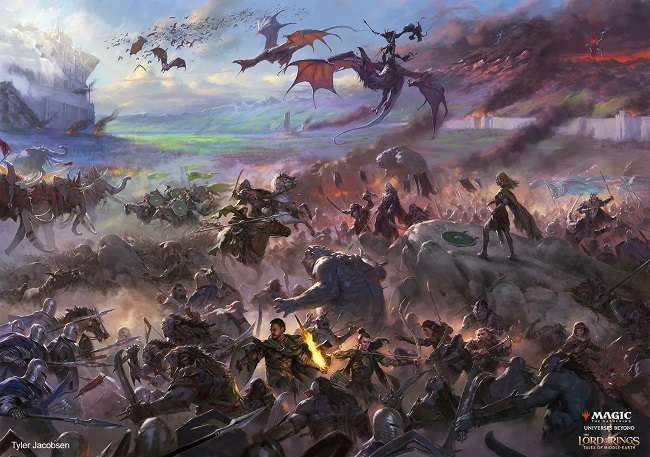
Ovidio: Correct, but right, absolutely not. It has to look like the best of you. And that's what I want to see. And that's what I want to bring out.
Mike: A question on people getting into Magic. It's a stage. It is a moniker you get to bring with you. I am a Magic artist. Sometimes a stopping point for a higher part of the mountain. But often just leaving art school is not enough. The quality gap is sizable. Are there things you're seeing that people are doing that are getting their portfolio more ready. Rather than emulating style, quality things they are doing an atelier or Smart school that might be different from even ten years ago?
Ovidio: I see a lot of artists who want to look like the market. And the fact that we live in a virtual environmental created by a digital cloud prevents many of us from going out into the world and lived, rich, textured experiences. As we speak right now, I walked here on pretty smooth floor. I didn't have to negotiate rocks, creeks, or roots as I walked over to this room. I think people need to learn how to get out there and experience the world and touch it, and experience people and observe people and study them. Rather than study what they post.
Many people are imitating photography or cinematic shots. And it's not always a great choice. You can't just imitate it. You need to understand how it works. Whatever you are doing, if you are doing a tree, you need to speak tree, if doing a crane shot, you need to speak crane shot. If you want blurred elements or if you want stuff that comes forward and the arm is about to touch you like that art...you need to learn human figure my friend. Because that is foreshortening. Many people want to do that but you need to take the time to study it, learn it. And not just academically. To live it!
The example I used, you need to navigate rough terrain. I think handmade art is not going anywhere for that reason. Because in many senses, it is about us conquering the material and as long as we have physical bodies we are not going to lose that desire.
Mike: I think that Ryan Pancoast's work, the Kenrith Family Portrait is a good example of this. He hired models for that, earlier in his process in doing that. He lives in Rhode Island - it's hard sometimes to find a modeling agency. But it went from here to HERE. Quickly. That portrait, you can't just invent those faces, you need the people, the reference, it has to be real. And it shows. No one tells you that. You have to just learn, and go across the bumpy road.
The good and hard questions are next. What's the most joyful part of your job and the most frustrating?
Ovidio: The most joyful part of my job sure. I'll give you a day to day. When finals are due, it's Christmas. Every. Fricken. Day. We get to see all this new art!
Mike: The "c'mon c'mon over, check this out. Wheel on over."
Ovidio: No, we do that!!
Meris: We totally do that on text channels. "HAVE YOU SEEN THIS PIECE?!"
Ovidio: I sit close to Zack Stella and Garcia and Taylor and I'm like hey, come check this out. We all do that with each other.
Mike: The Jason Rainville piece is in...
Ovidio: It's incredibly... no when that Rainville piece came in.
I just heard, I was sitting and Zack was like, "oh my goodness."
And I'm like oh my god what happened.
I was worried.
I turned around and I see this fricken masterpiece on his monitor and I was like, "What the hell. Dude, Rainville, what are you doing."
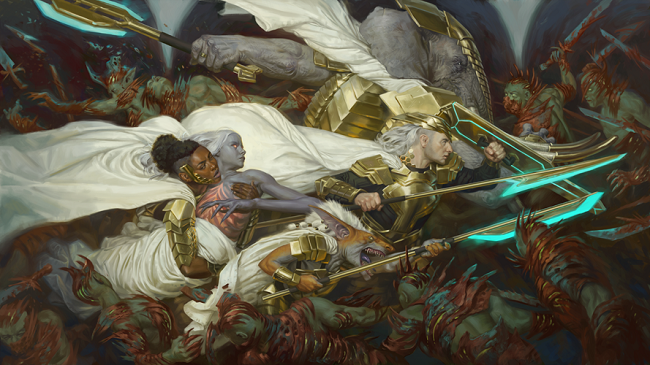
Storm the Seedcore by Jason Rainville
That's an everyday joy. It makes the hard parts easy.
Listen, it's a dream job. So it's pretty hard to find something that is very frustrating.
Mike: It is still a job.
Ovidio: But! Frustration is part of the process. As an artist I have learned (pauses) that I need to accept it, because if I'm frustrated it's because I'm about to have a breakthrough. You know?
Juggling many artists of different abilities, juggling that with creative work, code switching. Which means, I have to switch from sensitivity reader, to artist, to art director, to world builder, and among those? Different sets!
Like, "wait, what is this supposed to be?" Oh! Ravnica! Oh, I get it.
Next meeting, Phyrexia.
Next meeting, Ixalan.
Following is is "oh Ovidio, I don't know what to do! I'm having trouble with my family. Can I get an extension?" Like yes, relax.
Code switching is hard because you can't let the ideas seep into each other. I can't have a Ravnica idea for Phyrexia. And sometimes those meetings are back to back my friend. So, it's important to take a minute.
Meris: That spire is looking kind of sinewy...
Ovidio: Exactly. Why did you put teeth on this?
Ovidio: It's gets difficult. After doing that five times in a day, you are tired. It's a lot of intellectual jumping around. I'm just glad I work with the people I work with.
Meris: You're only saying that because I'm here. (laughs)
Ovidio: Well, there's more than just you I work with. It's a very good work environment and people are very understanding of when one is stumbling. Not everyone can be performing at the top of their game all day every day. That's not human. I think that's the toughest part for me. Changing on a dime.
Mike: And even after being there a few years, it's still that cadence.
Ovidio: Right, and you're still thinking about your mortgage. Your credit card. You got a call from home. And then my mom says, can you help me out. You have a life. You have to switch between your life and work. And at work, switching between many different worlds that have different philosophies.
Mike: Question for you then in the evenings. How do you find time to paint?
Ovidio: How do *I* find time to paint? Listen.
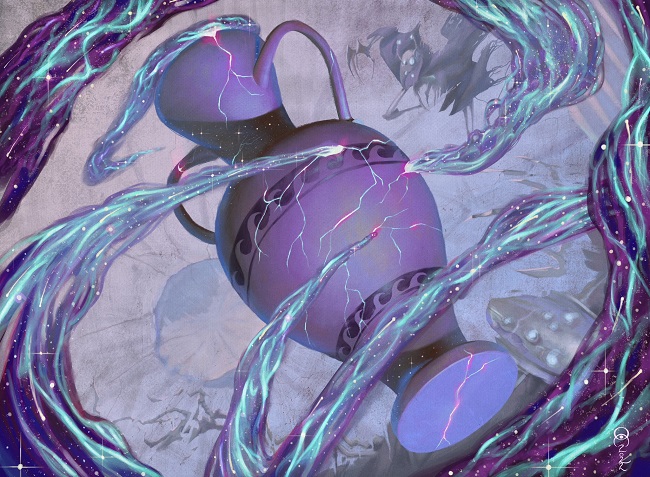
Urn of Godfire by Ovidio Cartagena
Mike: That's an easy question in theory. But I know many art directors who stop making art.
Ovidio: Yes. And I don't want to. The easy and short answer is, I neglect chores.
Meris: That is the correct answer. Yeah, it's about choosing.
Mike: I did not expect that.
Ovidio: Yes. Meris you tell him you're an artist too.
 Meris: Yeah I have a background in art. And I haven't painted anything since I had a child. I think I painted one thing and it's like, oh there's very little time. What do you choose? I think, to insert myself into the question. I think one of the other things I am observing about myself is that as a team manager, we did some heroic things in the first year of the Pandemic where we were trying to figure out how to keep...we used to all sit together, side by side, you could have conversations, you could work out like I'm struggling with this art description can you come look at it and help me and work through it. And suddenly when we all had to work remote because of COVID. All of our processes suddenly had to get restructured. We had to relearn how to document things in different ways. We couldn't just write something on a whiteboard and expect people to see it. Where do you put it, where do you save things, how do you make sure you've explained what you were doing so you can remember what it is after you've code switched five times. "What was I doing?"
Meris: Yeah I have a background in art. And I haven't painted anything since I had a child. I think I painted one thing and it's like, oh there's very little time. What do you choose? I think, to insert myself into the question. I think one of the other things I am observing about myself is that as a team manager, we did some heroic things in the first year of the Pandemic where we were trying to figure out how to keep...we used to all sit together, side by side, you could have conversations, you could work out like I'm struggling with this art description can you come look at it and help me and work through it. And suddenly when we all had to work remote because of COVID. All of our processes suddenly had to get restructured. We had to relearn how to document things in different ways. We couldn't just write something on a whiteboard and expect people to see it. Where do you put it, where do you save things, how do you make sure you've explained what you were doing so you can remember what it is after you've code switched five times. "What was I doing?"
I think I've seen and experienced myself is - We were doing that for so long, that some of us have forgotten what our boundaries used to be. What was a heroic effort for a year, just became normal and try to remind yourself to pull back. We've grown. We've added more people to the team and adjusted project assignments so Ovidio isn't on five assignments at the same time. Great, you're now only on two. And you're going to focus on two. And then you'll have a time where on three, but only for a little bit, and that one will end, and you'll be back on two again. I don't think it's exclusive to Wizards. All companies! All people are readjusting to life and that work life balance, trying to deal with the trauma of a Pandemic.
Mike: Quite literally the trauma. And still recovering and producing throughout trauma.
Meris: You heard me chuckling because my therapist would say your frustration is not actually motion. It's a manifestation of other emotions. Is it fear, is it anger or so on.
Mike: We didn't think that would come out either. All right, thank you.
I came here from your panel on diversity and inclusion here at Magic Con Minneapolis and I'm curious, how do you recruit artists?
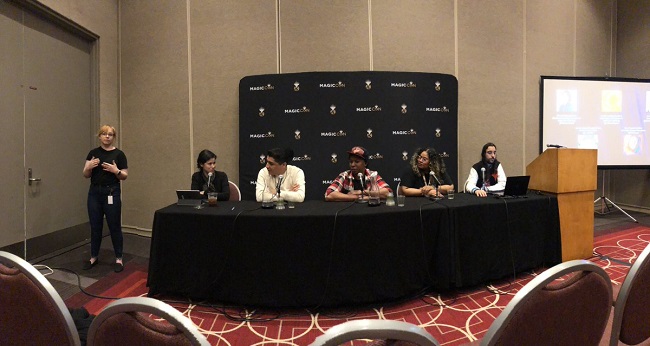
Image via @StalwartUrsa
Ovidio: How *I* recruit artists?
Mike: Yes, I know how artists can come into Magic. I know how they have.
Ovidio: I call them on the phone.
Nah, just kidding.
Like what methodology do I use?
Mike: Like especially in light of your last panel, it's very easy to find, as I look around the artist area here, and it looks like Magic has looked.
Ovidio: Listen my friend.
There's no simple way.
There's no marketplace of brown artists.
There's no such thing.
People have made practical lists. And I've gone through them.
Mike: I've written one before.
Ovidio: It's really putting the time in. You need to sit down and say, I am going to look for artists for three hours. And frankly, that search doesn't stop for me. Before I go to sleep, I am on instagram looking for artists. Every night. Every day. I have a whole list of artists who I want to sign up. It's a constant process. It doesn't end. It's just a habit like brushing your teeth. You have to live in that mode. But fortunately because I live in that mode, many people reach out.
Mike: Because they know you're searching? Because they know you're receptive?
Ovidio: I am quite approachable. I am not going to ghost people. People reach out and ask me, am I ready, what do you think. The, "how close am I."
Of course if I say close, it's not yet.
I don't give extensive portfolio reviews unless that's what I'm doing. Like if I go to a convention
Meris: And that's like your job there with sign ups?
Ovidio: Yes. People here ask, "what do you think of my work" and so on. I'll give them some time. We are here to talk to fans. It's the best space for a convention like this to talk to people.
Other artists refer people. I'm always open. And artists know that I'm very open to receiving recommendations. Of course, I'll take them, and think about it for when the right project comes along.
Mike: Meaning stylistic differences...
Ovidio: Yes, right and so on.
Meris: I'm not on the art team, but when I do spend time on social media, the various hashtags are very helpful. They're a helpful way for me to stumble onto new artists I might not have seen before. And what I'm also seeing is more of our veteran Magic artists reposting, resharing some of those. Which helps boost folks. I'll occasionally email the art directors, especially when I see someone who aligns with a project like "hey, this might be somebody you want to look at. I think the things they focus on align to the set you're working on, so maybe it's someone to look at it. They self-identify as such in their posts this week. If you're looking yet...
Ovidio: You've given me some artists too!
Meris: Yep.
Mike: It's a thing, the new normal you want out there. Even submitting to the art drop is a stage. You need to feel mentally and emotionally prepared. And sometimes people need a little something, a little nudge before that. A bit of encouragement.
That's good to hear. That's a piece I do want to mention.
Changing gears, I live in Minnesota and we have two very different indigenous communities. The Anishinabe and the Sioux. And it's very difficult to show visually in media and games. We're seeing Ixalan. But we haven't really seen any sort of American Indigenous culture in media other than things from the past. Less contemporary. We've seen Winona Nelson's elf. Wondering if there's anything you can say about anything in the future that's coming. Or we're working on? Or a stay tuned? Or a not yet?
Meris: Not yet.
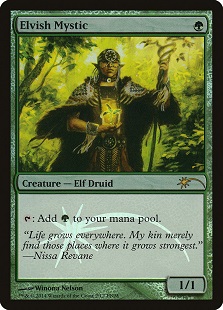 That's something I think about so often with my background in Archaeology and History and every single border across the world forced people who were not allies into the same area. Broadly, from worldbuilding it is an area of opportunity to deepen our knowledge. So, when we say, oh we are in Neon Dynasty and it is inspired by Japanese pop culture and anime. Getting the great feedback that, hey, the nunchucks are from a particular region, and understanding the nuance of how that came into the larger awareness and use across the country knowing that history and understanding of that stuff helps you make choices about what you're doing. I think that contributes to more successful representation and inclusion in the world building of the whys of how things happened instead of just "THAT LOOKS COOL I WANNA PUT THAT..." and then you've put the wrong clothing on the wrong character.
That's something I think about so often with my background in Archaeology and History and every single border across the world forced people who were not allies into the same area. Broadly, from worldbuilding it is an area of opportunity to deepen our knowledge. So, when we say, oh we are in Neon Dynasty and it is inspired by Japanese pop culture and anime. Getting the great feedback that, hey, the nunchucks are from a particular region, and understanding the nuance of how that came into the larger awareness and use across the country knowing that history and understanding of that stuff helps you make choices about what you're doing. I think that contributes to more successful representation and inclusion in the world building of the whys of how things happened instead of just "THAT LOOKS COOL I WANNA PUT THAT..." and then you've put the wrong clothing on the wrong character.
Meris: Let's return to that question next time we see you.
















